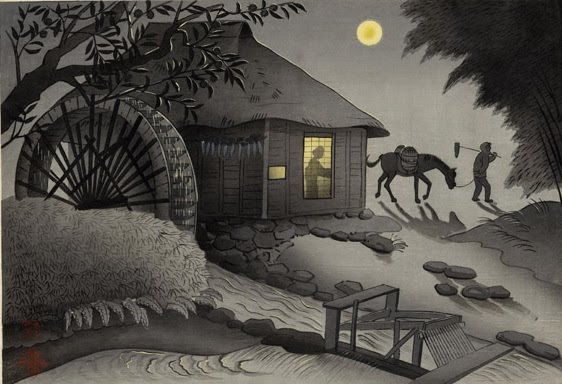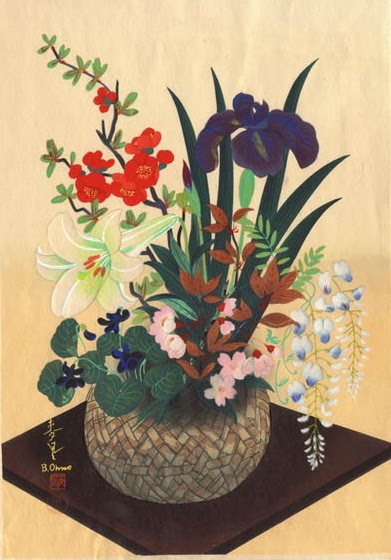
Ohno Bafuku (1888-1972) was a Japanese shin-hanga painter best known for his inspired naturely art works or sosaku-hanga (“creative prints”). Though nature is a frequent theme in Japanese art, Bafuku expresses an intensity and perspective that feels alternative to his era.
One need only see Mebaru (20th. CE; above) to appreciate its conceptual beauty. The scene takes place underwater —not exactly common ground. In this sense, the level of detail present in the fish and its surrounding environment is quite remarkable. A reddish seaweed plant suspends its branches effortlessly, with a hint of transparency that allows the rock fish’s dotty texture to peek from underneath. Shadows are prominently displayed throughout Mebaru’s canvas, perhaps ominously as a brush with the Japanese Sting Fish can be deadly. Yet, Mebaru’s organisms flow harmoniously through the plane.

Prominent shadows are often seen in Bafuku’s works, and may be one of his defining artistic features. Take, for instance, Katsura Garden in Kyoto:

In this wonderfully moody woodblock print, Bafuku has managed to convey both the beauty and homeliness of a somber, introspective disposition. The house is only dimly reflected on the quiet river, stimulating curiosity as to what lies beneath.
Even though dark tones are prominent on Katsura Garden in Kyoto, their starkness amplifies the brightness of the snow. Likewise, the hearth stands out as the only element in the painting that is decidedly earthy. A faint warmth is discernible in the horizon as the sun either sets or rises. Other elements, such as the bold outlines surrounding the pathway and the sharp contours of the grass, uplift the scene as one of quiet power.

Besides his blooming body of naturely work, Bafuku also painted interesting human-driven environments. One such work is Night Scene of Water Mill:

In Night Scene of Water Mill, Bafuku unveiled his creative prowess by creating essentially a black and white analog photo of a homestead at night. A splash of pale golden moonlight provides light to the whole scene. The brightness of the window mirrors the moon as light source. A woman’s silhouette stands by the window, ostentibly at labor, while a male figure walks towards the forest accompanied by his horse. The use of shadow is prominent throughout the scene, artfully coexisting with various tones of surrounding light. ‘Twas rather bold of Bafuku to create a woodblock print in grayscale, so kudos to him for Night Scene of Water Mill.
Besides his dexterity with shadow and tone, Bafuku was also an expert colorist. Some of his most masterful applications of hue can be noted in Flowers in Bamboo Basket:

And in the joyful correspondence between Finch and Orchid:

In an interesting turn of events, it is the orchid and its ample mane of grassy sheaths that creates a sense of action in the scene. The lovely finch stands underneath the orchid’s blades; its yellow and reddish plummage artfully corresponding with the orchid’s own prominent pinkish hue. A cognizance of shadow and tone is once again seen throughout the soil, emphasizing the orchid’s stability relative to the finch’s propensity for flight.
In an artistic coup de grace, Bafuku’s range in both color and shadow can be appreciated in Flowers in Vase:

and background. The bamboo’s zagging arrangement creates motion
in an otherwise dreary landscape.
Thank you for reading! If you would like to learn more about Ohno Bafuku, you can go here and here.
Leave a Reply